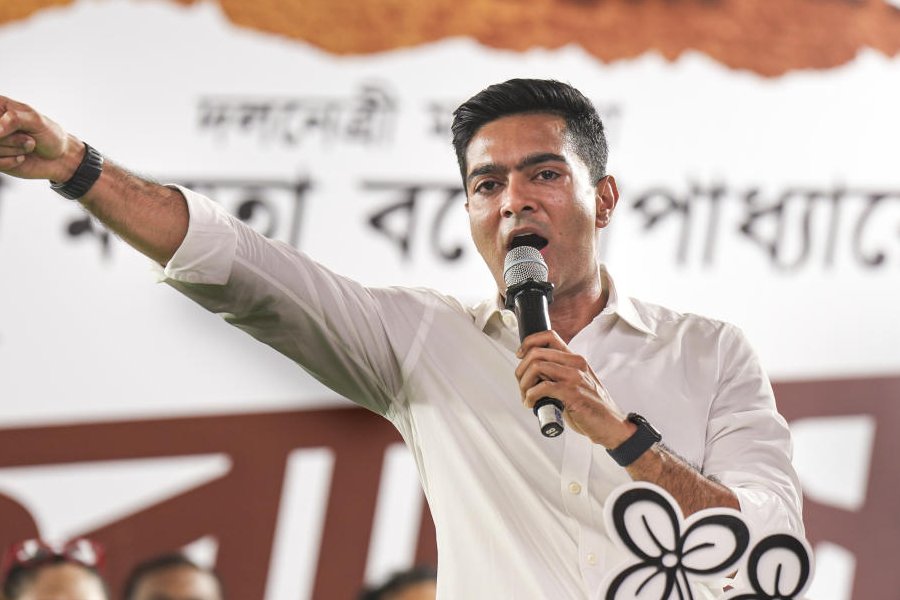 |
| Sharmishtha Paul shot to fame as the playback singer of the hugely successful Bengali serial Ganer Opare Pix by Rashbehari Das |
sThe coming months will be busy ones for vocalist-turned-Rabindrasangeet singer Sou-nak Chattopadhyay, 30. He’s currently touring Canada, singing at one venue after another after which he returns to Calcutta for a string of performances. Then, in a few months, he’ll be heading off to New York where he’ll be performing with 16 other world musicians. In between all that, he’s just about to release his next album, Notun, in which he has experimented hugely. The music has been influenced by everyone from Mozart to P Nayyar and Yanni, the Greek composer and singer. The arrangement has been done by Gautam Shome and the album also has recitals of Rabindranath Tagore’s poetry and play excerpts by actor Soumitra Chatterjee and actress Chaiti Ghoshal.
Or, look at 30-year-old Kamalini Mukherji whose Rabindrasangeet album Esecho Prem last year was a smash hit by Bangla music standards. She’s currently working on the post- production of another Rabindrasangeet album, Bibagi Hiya, which will launch by end-May. “My forte lies in understanding the meaning of the words correctly and presenting it with the right expression. Tagore’s writings are intellectually rich and if you fail to understand the significance of these words your rendition becomes lacklustre,” she says.
 |
| Kamalini Mukherji stresses the importance of understanding the meaning of the lyrics of Tagore’s songs and presenting it with the right expression |
Sounak and Kamalini are two leading lights of the new generation of Rab-indrasangeet singers who are wowing listeners both with their style of singing and also their experimental work. “In a year when the country is celebrating Tagore’s150th birth anniversary, it’s heartening to see that Rabindrasangeet is still a favourite choice for youngsters. What’s striking is that all of them are singing in their own style and are able to make a mark,” says ace Rabindra-sangeet singer Srabani Sen.
The popularity of Rabindrasangeet has never waned in Bengal. But the new generation of singers is helping to give the genre a fresh feel. Take a look at Sasha Ghoshal who is another rising star on the Rabindrasangeet firmament. He’s about to launch his sixth album Baela this month and in it he has experimented in a big way. Says Ghoshal: “In my earlier albums I used various forms of music — everything from South American beats to Carnatic music — and even used Indian classical instruments like the sarod, sitar and tabla. In my forthcoming album, I have given rock and jazz treatment to songs wherever necessary without distorting the original tune.” Ghoshal, incidentally, was born and raised in Toronto and he first studied piano there and also received training in Indian classical music. In 1990 when the Calcutta-based music school Gitabitan opened a branch in Toronto he started training in Rabindrasangeet.
 |
| Sounak Chattopadhyay has used both Indian classical and Western instruments to bring out the richness of Tagore’s songs; (below) Rohini Raychaudhuri’s album Transcreations was a compilation of Scottish ballads and Irish melodies that had inspired Tagore Pix by Rashbehari Das |
 |
Are these new singers injecting new life into Rabindrasangeet? “These youngsters have grown up listening to legends in this field. They are trying to stick to the true form of Rabindra-sangeet without any imposed mannerisms. They are smart, have a fresh appeal in their voices and are not copying anybody,” says Sen.
Certainly, the music companies are pleased that there’s a renewed interest in Rabindrasangeet and it’s back in the music charts once again. Says S.F. Karim, head, Bangla content, Saregama: “Though Rabindrasangeet never went out of fashion, the scenario is looking brighter today as more young faces are cutting Rabindra-sangeet albums. Today, this genre enjoys 25 per cent of the market share (in the Bangla music field) and it is definitely in growth mode.”
Certainly, Bengali youngsters of all kinds are still enthusiastic about Rabindrasangeet. Sudeb Guhathakurta, principal and general secretary, Dakshinee, the premier Rabindrasangeet school in south Calcutta points out that this institute has 1,200 students and has just had 300 applications this year. “There’s outstanding talent and many in this generation are willing to learn Rabindrasan-geet in its traditional form. The number of applications we got this year proves that Rab-indrasangeet is not going to fade out soon.”
There are others who are attempting to popularise Tagore’s songs not only in India but abroad. Shreya Guhathakurta, for instance, lives in Paris but spends a lot of time doing performances in India. After her latest solo album, Surer Dariyay, which has been launched in Bangladesh, she is upbeat about her next solo album Anandodhara. Guha-thakurta was heavily influenced by Rabindrasangeet legend Kanika Bandopadhyay. Says Guhathakurta: “As a child I was mesmerised by Mohordida (Kanika Bandopadhyay) who was a regular at our house. So in Anandodhara I have sung some of the songs which were earlier immortalised by her. That does not mean that I have emulated her — I have tried to sing those same songs in my own style.”
Besides performing in her hometown, Shreya also teaches in Paris and in the UK. “I take online workshops over Skype for Bengali students settled in London and Paris,” she adds. This year her diary is packed with several Rabindrasangeet assignments in various parts of the world. Coming up is a US tour in July followed by a Tagore Festival in Berlin and another one in Singapore in August. She’ll also be singing at a performance of Tagore’s Bhanu Singher Padabali in Paris in September.
 |
| Toronto-based Sasha Ghoshal is excited about his sixth Rabindrasangeet album Baela Pix by Gajanan Dudhalkar |
But the most interesting thing about the new clutch of singers is that they are experimenting vigorously. “Today’s singers are very open to newer ideas and concepts. But this does not mean that they are not singing in the traditional format,” says Sounak. So, where once the esraj, harmonium and pakhawaj were the only accompanying instruments, today there are a variety of instruments used like keyboards, piano, the sarod, flute and sitar.
So Shreya has already experimented with the music arrangement in her album Mon Bhulai Re where she used western instruments like cello and violin. Similarly, Sasha too is “open to new concepts” and has used various musical instruments like drums, guitars, piano and even the African Djembe to heighten the effect of certain songs. And Sounak has used both Indian classical and Western instruments to bring out the richness of Tagore’s songs in an earlier album Nuton Sonaton Rabin-dranath that was released last year.
Other singers too are working hard to popularise Rabindrasangeet. Take 22-year-old Rohini Raychaudhuri who along with her singer father Debashish is working on a project titled ‘How Magically You Sing?’ (Tumi Kemon Kore Gaan Koro He Guni) which they will present in the UK in May along with London-based Tagore scholar William Radice and elocutionist Louise Coigley. “Here we will demonstrate the various moods and nuances inherent in some of the songs,” says Rohini.
This apart, she’ll also be singing Rabindrasangeet from Tagore’s Gitanjali at the Tagore Centre in London. “The objective is to reach out to people who are not familiar with Tagore’s work,” she says. She and her father have released several albums including The Dust and the Sunlight that was a compilation of songs from Gitanjali. In it, the father and daughter duo sang the original Rabin-drasangeet in Bengali and Louise Coigley recited the English translations done by Radice. Also they’ve released another album, Transcreations, which was a compilation of Scottish ballads and Irish melodies which had inspired Tagore. Besides singing with her father, Rohini is also concentrating on creating her own mark and last year she released her first solo album called Aamar Mon Mane Na.
At another level, there’s also Sharmishtha Paul, 25, who came into the limelight as the playback singer of the hugely successful Bengali serial Ganer Opare where she sang all the songs for the female protagonist Pupe (Mimi Chakroborty), who is a Rabindra-sangeet singer in the show. “Before this, I worked briefly for the background scores of Chokher Bali and Raincoat with Debajyoti Mishra. But Ganer Opare has been a biggest milestone in my career.”
 |
| Shreya Guhathakurta does online Rabindrasangeet workshops over Skype for Bengali students settled in London and Paris Pix by Rashbehari Das |
But Paul’s career has changed after the serial. “I am getting a lot of stage shows and right now I just want to concentrate on singing Rabindrasangeet,” she says. Paul, who launched her first album, Moner Katha, last year is working on her second album which will be released this year.
Meanwhile, 33 year-old Shamik Pal’s career too, is swinging to a lively beat. Shamik who is a regular with a Calcutta-based music-channel, Tara Muzik, says that, “show offers are coming in thick and fast after the success of his music programmes Chirontoni and Aaj Shokaler Amontrone on Tara Muzik.” Currently, however, Shamik is concentrating on doing more live shows in Calcutta.
Training has been an integral part for all these newcomers. So Shreya, Rohini, Kamalini and Shamik are former students of Dakshinee and Sharmistha studied under Srabani Sen. Similarly, Sounak honed his singing skills under Pramita Mallick while Sasha took music lessons under various teachers.
So what’s the future for these newcomers? Seasoned Rabindrasangeet singer Sen has a word of advice: “There’s immense pressure on these youngsters to perform. But one should always complete training first before thinking of shows and live performances. Also as a singer, you should know the meaning of the lyrics and ensure that your expressions are right. I also feel that experimentation in good taste is acceptable but one should not tamper with the original lyrics and melodies.”











